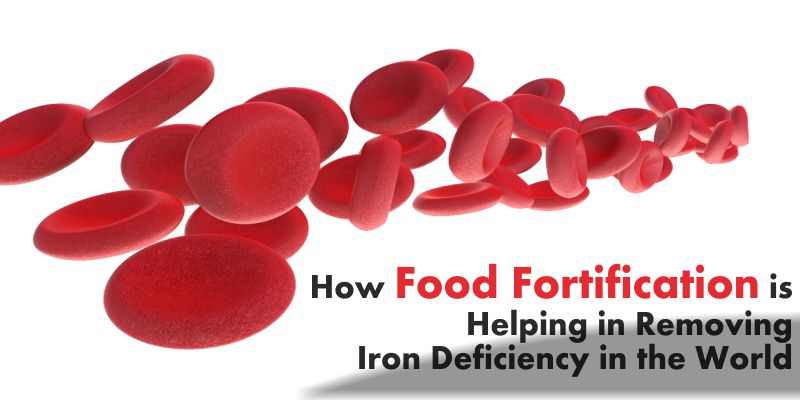Anemia is common among both undernourished and nourished people. Iron deficiency is the most common hematological disorder involving about 30% of the world population. This disease most often affects children, women of child-bearing age and pregnant women. Its prevalence varies according to the region and socioeconomic conditions.
Ideally, we should get all the required vitamins and minerals from the food we eat but unfortunately, that is not the case. The daily food doesn’t provide us a sufficient amount of nutrients. Especially in poorer countries, people don’t have affordability and access to nutria-rich food which ultimately results in poor health conditions. According to research, today around 2 billion people survive on diets that lack the vital vitamins and nutrients that are needed for their proper growth, live a healthy lifestyle, and raise a healthy family.
WHAT IS FOOD FORTIFICATION PROCESS?
Food fortification is the process of adding essential micronutrients i.e. vitamins and minerals in food. This process helps improve the nutritional quality of the food supply and provide a public health benefit with minimal risk to health. Food fortification process is sometimes voluntary and sometimes mandatory. It can be done by food manufacturing companies or by governments as a public health policy.
ERADICATION OF IRON DEFICIENCY THROUGH FOOD FORTIFICATION:
Iron helps in carrying oxygen through the lungs and around the body to maintain a healthy nervous system. Deficiency of iron leads to anemia, which causes many problems such as delayed development in children, affect the mental functioning of teens, depression and decreased productivity. It is also the leading cause of maternal death. Iron deficiency impacts not just individuals but populations.
Food fortification has been considered by some authors to be the best strategy to increase iron intake of a population, especially for children and pregnant women. The World Health Organization (WHO) recognizes four types of fortification to eradicate the problem of iron deficiency in the world: universal or mass, open market (commercial), targeted (for high-risk groups), and household and community fortification.
UNIVERSAL IRON FORTIFICATION OF FOODS:
The fortification of wheat flour with iron has been used in Canada, Great Britain, and the United States since 1940 for controlling the iron deficiency. In North America and Europe, the fortification of staples and condiments has been practiced since the 1920s, and it has greatly contributed to the virtual eradication of diseases like pellagra, goiter, beriberi, and scurvy.
In recent years, there has been a growing interest in fortification programs in developing nations too.
Over the last ten years, food fortification has gained global traction and its positive impact on the health of people in low and middle-income countries are growing. Now, over 140 countries have national salt iodization programs, 85 countries mandate at least one kind of cereal grain fortification with iron and folic acid, and more than 50 countries mandate the fortification of at least one kind of edible oil and ghee with vitamin A.
BENEFITS OF FOOD FORTIFICATION:
There are multiple benefits of the food fortification process –
- Fortification is a secure method for improving nutrition among people. The quantities of micronutrients added to the food items are small and added according to the recommended standards by FSSAI/WHO etc
- It is one ultimate way to remove malnutrition from Indian population without forcing people to change their regular food consumption pattern.
- The method is cost-effective to prevent nutritional deficiencies
- Under the food fortification process, micronutrients are added to wheat & Maida products in such a small quantity that the characteristics of food items remain unchanged.
- The nutrients regularly used in grain fortification process prevent diseases, strengthen immune systems, and improve productivity and cognitive development. The edible items like wheat flour, maize flour and rice are primarily fortified to prevent nutritional anemia.
- It is very beneficial for infants because they require more iron during their growing stage so their food can be iron fortified to meet their needs.
TYPES OF IRON FORTIFICANTS AVAILABLE:
for the betterment of food fortification worldwide, there are few types of iron fortificant are available to make fight against iron deficiency anemia. The iron forms like Electrolytic Iron, Reduced Iron, Ferrous Sulfate, Ferrous Fumarate, Ferrous Sodium EDTA etc. Out of this different forms, electrolytic iron is the most stable, economical, highly pure, easily available, high shelf life, No sensory issues, easy to test compared to other iron forms available in the world. Hence, most of the industries, manufacturers, or end users prefer to use Electro-Fine grade of electrolytic iron powder to help to remove iron deficiency anemia which a big challenge to all of us.
CONCLUSION:
Several measures are being taken by different health organizations across the world to eradicate the iron deficiency through food fortification. Performing the food fortification process using electrolytic iron powder and other vitamins and nutrients are the ultimate solutions to reach out to the entire population of the world.
Electro-Fine is one of the best alternatives for iron fortification. Food prices are going up and more importantly country like India, we need an affordable & viable solution for flour fortification which can sustain in the long term independently without donation or support.






